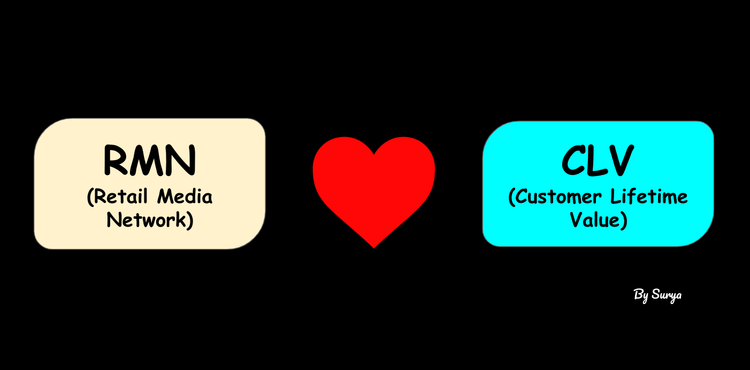Decoding Retail Media and Its Future Trajectory

As the Retail Media Network (RMN) industry is poised to double in value to an astonishing $107 billion* Over the next five years, it’s time to take a closer look at two critical aspects: the "operational intricacies" of retail media and the "future direction" of the Retail Media Network.
Understanding the Retail Media Framework (Operational)
The realm of retail media companies is vast and complicated. As these companies move toward full automation and a mature network, their operational scope, stakeholder engagement, technological integrations, service offerings, and workforce expand at an accelerated pace.
In the early stages, a Retail Media Network (RMN) may focus on monetizing its first-party data. Over time, the focus shifts to areas like Search, then Onsite Display and Video.
The evolution does not end there; the focus then shifts to off-site strategies, necessitating consideration of programmatic avenues. Delving into in-store dynamics introduces another layer of complexity, necessitating partnerships that range from software to hardware technology providers, measurement specialists, and internal personnel coordination.
In this rapidly changing environment, staying up-to-date on technological innovations—set by pioneers like Google, Meta, and Trade Desk—is critical. For companies to succeed in this area, a deep understanding of the nuances and the ability to adapt quickly are essential.
Ensuring alignment with the needs of their brand clients and, most importantly, meeting the demands of end consumers—the people who make up the market—is critical to their success.
Redefining In-Store Retail Media in a Post-Pandemic World
The evolution of the post-pandemic retail landscape has been notably marked by the rise of omnichannel retail media. While the E-Commerce GMV baseline has surged and continues to be higher pre-pandemic, indicating a robust growth in online transactions, it's crucial to understand that today's consumer journey extends well beyond traditional e-commerce platforms.
The consumers (especially in certain sectors like Grocery) have come back to the store and the journey has become more sophisticated than ever before. In the past, e-commerce was a straightforward process of product awareness, research, consideration, cart addition, purchasing, and potential repeat business.
In the current omnichannel paradigm, however, the journey is more intricate. Consumers might begin their shopping experience on an app, noting the nearest physical store. They can curate a shopping basket with options to have items delivered, or even opt for in-store pickup. Alternatively, they might merely compile a wish list in the app and complete the purchase in a brick-and-mortar setting or another online platform.
These multifarious shopping pathways bring forth a challenge for retail media: determining the most effective way to measure the impact of advertising in such a diversified environment. It's evident that for retail media to remain relevant and effective, it must seamlessly integrate its strategies across all these channels, ensuring a cohesive and resonant message for consumers.
A retailer's physical store is its most valuable asset, and in-store media is a key component of its omni-channel retail media strategy.
In-store media refers to the various forms of communication and advertising methods used within a brick-and-mortar retail environment to engage, inform, and influence customers. This can include a range of elements such as:
Digital Signage: Digital signage refers to electronic displays, often using screens or projectors, that show advertisements, information, or other content within public or commercial spaces.

TV Wall ads are advertisements displayed across a series of interconnected screens or monitors, creating a large visual canvas in public or commercial spaces. Here is an example of TV Wall ads in Walmart Stores.

Self Checkout Ads - Self Checkout Ads are advertisements that appear on the screens or interfaces of self-checkout kiosks in retail stores. As customers scan and pay for their items using these self-service machines, these ads are displayed, offering an opportunity for brands and retailers to promote products, provide special offers, or relay important information directly to the consumer during the checkout process.

In-Store Demonstrations - In-store demonstrations are live presentations within a retail setting that showcase a product's use and benefits, often allowing customers to interact with or sample the product before purchasing.

In-store radio is a customized audio broadcasting service played within a retail environment, often featuring music, advertisements, and announcements tailored to the store's brand and its customers. Example from Walmart Radio.
The Next Phase - Bringing everything Together
Retail Media networks are evolving to combine all of their elements, including digital and in-store channels, proprietary assets, and external programmatic platforms. One of the biggest challenges is measuring the effectiveness of these networks across all of these different channels.
It is easier to measure the effectiveness of digital marketing campaigns, but it is more difficult to measure the effectiveness of in-store promotions. One way to measure the effectiveness of in-store promotions is to compare sales data from promotion periods to non-promotion periods.
Retailers are developing new ways to measure the effectiveness of in-store promotions using sophisticated analytics and machine learning techniques. These new methods will use data from the past and from IoT devices to predict the outcomes of future in-store promotions. This will help brands make better decisions about their marketing campaigns.
Embrace this journey with us as we explore, decode, and shape the future of the Retail Media Network.





Member discussion